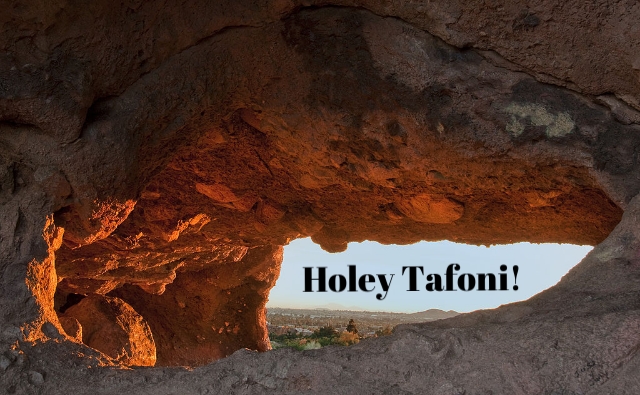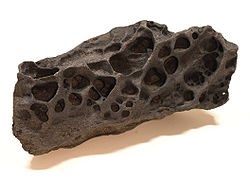For purposes of logging this cache you must answer the following four questions from INSIDE the Tafoni.
1) How many Tafoni are located here?
2) How many steps are carved into the rock on the WEST side in order to get up to the opening? These can be counted using the EAST trail. Once you get inside simply go to the west opening and count down.
3) Compare and contrast the floor of the cave to the sides and top. Noting color, texture and variations within the rock surface. What do you think caused the variation?
4) What type of weathering do you think caused the Tafoni here and why?
5) Mandatory picture taken at the coordinates inside the Tafoni either of yourself or a personal item.

 This earthcache is located at Hole-In-The-Rock, a natural geological formation in Papago Park.Note: An earthcache is the magical combination of geocaching and geological discovery. They vary greatly from traditional geocaches in that there is NO PHYSICAL CONTAINER! Once at the Earth Cache site, take in the scenery, the geological marvels or oddities, and read the cache description. You will likely be asked to answer some questions about the site and optionally take a picture. You can email the cache owner or use the Message Center to send answers to the required questions. Please don’t be intimidated about answering the questions. They are not graded and were meant to enrich your visit, open your eyes and provide you with new knowledge and insights about the location. Most importantly have fun!
This earthcache is located at Hole-In-The-Rock, a natural geological formation in Papago Park.Note: An earthcache is the magical combination of geocaching and geological discovery. They vary greatly from traditional geocaches in that there is NO PHYSICAL CONTAINER! Once at the Earth Cache site, take in the scenery, the geological marvels or oddities, and read the cache description. You will likely be asked to answer some questions about the site and optionally take a picture. You can email the cache owner or use the Message Center to send answers to the required questions. Please don’t be intimidated about answering the questions. They are not graded and were meant to enrich your visit, open your eyes and provide you with new knowledge and insights about the location. Most importantly have fun!
From parking take the trail EAST and follow the trail to posted coords, the inside of the tafoni. You must answer the questions in order to successfully log this earthcache.
What are Tafoni and Where are they found?
The word itself is something more of a mystery than the reasons why tafoni are formed. There are several options here – Greek readers will immediately recognise the word taphos which means tomb. In Sicilian and Corsican the word means windows, while in the latter language, tafonare means to perforate. Tafoni are naturally forming circular or ellipsoidal rock cavities. These weathering features include tiny pits, softball-sized cavities, and even truck-sized caves! Tafoni typically develop on inclined or vertical surfaces. They can be found in many different types of rock and in many different environments (including Antarctica and Mars), but they are very common in sandstones and in the deserts of the world.
How do they form?
Formation of tafoni is completely dependent on the region in which they’re found. Although it’s not known for sure how tafoni form, there are a number of hypotheses that try to answer the common questions surrounding their formation:
Salt Weathering - salt crystals form in a small cavity and knock off rock particles. Over time, the cavity grows with every particle that is dislodged.
Chemical Weathering – chemicals in ground water create a harder surface when they exit the rock. This allows for the rock face to erode at different rates with the hardened areas eroding slower which causes the pits to erode faster and more dramatically.
Biological Weathering- biological weathering is another possibility. Creatures such as snails, plants, fungus, etc. often secrete different chemicals and acids into the environment around them, which can weaken the rock. Other forces, such as water, wind, etc. can then more easily weaken and weather and erode the rock. The nearby lichen is a possible candidate, as are other organisms that may grow along the surface.
So how did these peculiar holes form here? Hopefully by using this lesson and what you observe on the hike you can make an educated guess. Thanks for visiting!
About the trail:
Hole-In-The-Rock Trail - Easy trail, mostly smooth & wide. Good for all ages.
Length: Very short, about 1/10 of a mile.
Elevation gain: about 200 feet
The trail up the mountain is smooth and well maintained. The trail wraps around behind and east of the mountain to the entrance to the cave. Even though this trail is very short it gains all of its elevation in a very short distance and ends with some very nice views.
Parking is free and is located right next to the trailhead. Follow the signs.
History of Papago Park and Hole-In-The-Rock:
There is some evidence that the Hohokam—a now-extinct aboriginal tribe that once lived in the Phoenix area—used the openings of Hole-in-the-Rock and sunlight to track the solstices.
Papago Park was designated a reservation for the local Maricopa and Pima tribes of aboriginal Americans in 1879. It became the Papago-Saguaro National Monument in 1914, but this status was recalled by Congress in 1930.
During World War II, the park housed a POW camp and contained as many as 3,100 prisoners from 1942 to 1944.
After the war it served as a VA hospital from 1947 to 1951.
Hunt's Tomb is also located within the park and is listed on the National Register of Historic Places. George W.P. Hunt (Arizona's 1st governor) had the tomb built in 1931 to entomb his wife. He was placed there after his death in 1934.
| EDUCATIONAL LOGGING REQUIREMENTS
In order to substantiate your visit and comply with the educational requirement for Earth Caches you have to submit your answers to the following questions to the cache developers via their profile:
For purposes of logging this cache you must answer the following four questions from INSIDE the Tafoni.
1) How many Tafoni are located here?
2) How many steps are carved into the rock on the WEST side in order to get up to the opening? These can be counted using the EAST trail. Once you get inside simply go to the west opening and count down.
3) Compare and contrast the floor of the cave to the sides and top. Noting color, texture and variations within the rock surface. What do you think caused the variation?
4) What type of weathering do you think caused the Tafoni here and why?
5)Mandatory picture taken at the coordinates inside the Tafoni either of your self or a personal item.
|
Resources:
http://www.kuriositas.com/2011/08/tafoni-natures-rock-art.html
https://prezi.com/gzxtbcxl4_nl/papago-park-geology-overview/
http://throughthesandglass.typepad.com/through_the_sandglass/2009/02/tafoni.html
https://en.wikipedia.org/wiki/Papago_Park